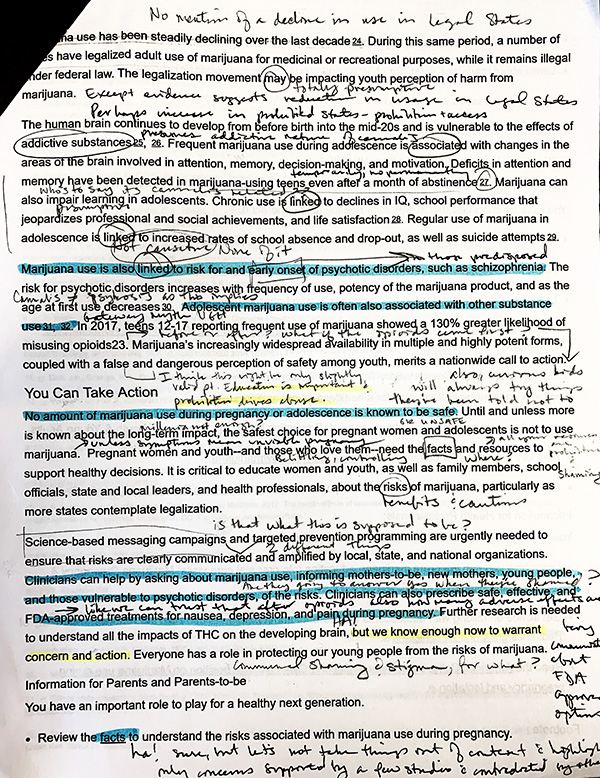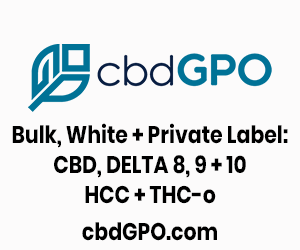Responding to the Recent U.S. Surgeon General Cannabis Advisory
Marijuana Industry News October 2, 2019 MJ Shareholders
In August, on the heels of a Drug Enforcement Administration (DEA) announcement that it would finally begin to expand certifications for cannabis cultivation facilities in an effort to increase access to research material, U.S. Surgeon General Dr. Jerome Adams released a warning against the dangers of “marijuana” use and the developing brain.
Before the 1930s, “marijuana” was in every medicine cabinet in America. Known by its scientific name, Cannabis, it had been a staple of the United States Pharmacopoeia, most often purchased and prescribed in tincture form, until it was dropped in 1942 after the Marihuana Tax Act of 1937 rebranded this common household item, now referred to as “marihuana”—a pejorative stab steeped in anti-Mexican sentiment.

I start here because the language—and the evidence—we use to describe this pharmaceutical powerhouse matters.
While the surgeon general was not wrong to consider concerns in much the same way one would expect any medicinal product to be scrutinized to ensure safety, the decision to use the term “marijuana” throughout, the alarmist rhetoric and the cherry-picked references chosen to highlight the perceived consequences of cannabis without mention of its proven benefits hark back to a foundation of misinformation first laid just a century ago.
Let’s unpack the statement. Adams’ original text is in italics.
U.S. Surgeon General’s Advisory: Marijuana Use and the Developing Brain
I, Surgeon General VADM Jerome Adams, am emphasizing the importance of protecting our Nation from the health risks of marijuana use in adolescence and during pregnancy. Recent increases in access to marijuana and in its potency, along with misperceptions of safety of marijuana endanger our most precious resource, our nation’s youth.
With his very first sentence, the surgeon general describes cannabis use as an epidemic. A paternalistic tone is immediately taken to convey a need to protect the consumers in question from their own choices, for themselves and their children.
As to its safety, unlike many of the FDA-approved pharmaceuticals consumers are now regularly choosing to replace as access to the plant grows, thousands of years of plant-based cannabis consumption have proven both its efficacy in treating a wide variety of symptoms and conditions without the risk of fatal overdose. We have millennia of evidence.
Additionally, uncomfortable side-effects associated with over-medication of the intoxicating compound THC are generally short-lived, resolving after cessation and are preventable with careful consumption. This describes a need for education, not prohibition. Even high doses of synthetic THC preparations – the pharmaceutical-made, FDA-approved kind we see in lab and clinical studies that don’t bind to receptors in the body the same as plant-sourced cannabinoids and can increase unpleasant outcomes when not carefully dosed – have an extraordinarily high toxicity threshold.
Background
Marijuana, or cannabis, is the most commonly used illicit drug in the United States. It acts by binding to cannabinoid receptors in the brain to produce a variety of effects, including euphoria, intoxication, and memory and motor impairments. These same cannabinoid receptors are also critical for brain development. They are part of the endocannabinoid system, which impacts the formation of brain circuits important for decision making, mood and responding to stress.
Dr. Adams doesn’t seem to have a keen grasp on how the endocannabinoid system works. Cannabis engages receptors in both the brain and the body to regulate systemic homeostasis and optimal wellness. In addition to producing the fearful effects of euphoria described – thereby capable of increasing mood elevation and decreasing the negative health outcomes associated with stress – it can also optimize sleep, digestion, memory, pain responses, as well as neural and immune activity.
Two other things to keep in mind here: cannabis is only illicit because the US government stubbornly refuses to remove it from the Schedule 1 list – substances and compounds defined as drugs with no currently accepted medical use and a high potential of abuse – despite centuries of studies (including by the US government 1944, 1972) that describe safe and effective administration. Second, if its use is so wide-spread and it were as dangerous as Dr. Adams suggests, we would have seen far more data to back up that claim. Think opioids, which have only been prescribed at current rates since the 1990s but took over 70,000 lives in 2017 alone.

Additionally, a healthy endocannabinoid system is critical to brain development. A deficient system may need to be supplemented to prevent and treat any number of symptoms and diseases caused or affected by those deficiencies. Of course, to be fair, a healthy ECS does not need supplementation and healthy kids not in need of the symptomatic treatment cannabis can provide are wise to avoid consumption until brain development is complete – especially chronic consumption. For those who need it, the concern over a few-point drop in IQ is outweighed by the avoidance of, say, death from seizure.
Marijuana and its related products are widely available in multiple forms. These products can be eaten, drunk, smoked, and vaped. Marijuana contains varying levels of delta-9-tetrahydrocannabinol (THC), the component responsible for euphoria and intoxication, and cannabidiol (CBD). While CBD is not intoxicating and does not lead to addiction, its long-term effects are largely unknown, and most CBD products are untested and of uncertain purity.
While chronic cannabis consumption does encourage the development of tolerance to intoxication, therapeutic tolerance remains stable. This is great news for someone who needs to work their way up to large doses of THC to treat certain types of cancers, for instance. And, though mild symptoms of withdrawal upon THC cessation may occur, the claim that THC is addictive – comparable to alcohol or opioids – is more of an inflammatory statement than a proven truth and disregards a host of variables.
In this same sentence, Dr. Adams also claims that the long-term effects of CBD are unknown. This is mostly false. True, the synthetic compounds being developed by the pharmaceutical industry are unknowns, but these synthetics and derivatives are also not reflective of the natural beneficial synergies found in whole-plant cannabis products. Cannabis produces hundreds of phyto-pharmaceutical compounds that work together in what is known as the ensemble effect that help reduce unwanted outcomes and that have been ingested by humans – not lab rats -since the first cannabis cultivation.
To be fair, the point on purity is a concern in an unregulated market without strict testing guidelines and requirements. However, this is a failure of the government’s unwillingness to create safe access, not an issue stemming from the plant itself.
Marijuana has changed over time. The marijuana available today is much stronger than previous versions. The THC concentration in commonly cultivated marijuana plants has increased three-fold between 1995 and 2014 (4% and 12% respectively). Marijuana available in dispensaries in some states has average concentrations of THC between 17.7% and 23.2%. Concentrated products, commonly known as dabs or waxes, are far more widely available to recreational users today and may contain between 23.7% and 75.9% THC.
While it is true that THC potency has increased as research and development in legal markets explore the limits of what the plant is capable of producing, having potent options available to those with debilitating conditions and high tolerances is important. Even if we compare cannabis to alcohol consumption purely for the purpose of intoxication, it’s a matter of choice. Do you prefer beer or hard alcohol? Do you change your consumption levels when the ABV goes up? It’s about common sense consumption – a feat far easier to achieve with cannabis than alcohol and with far fewer detrimental consequences. For instance, the CDC reports that “excessive alcohol use led to approximately 88,000 deaths and 2.5 million years of potential life lost each year in the United States from 2006-2010.” And despite alarmist rhetoric that THC has been associated with recent reports of vaping toxicity – meaning there was THC present in some of the contaminated products, NOT that THC was the cause – regulated, plant-sourced cannabis products have never resulted in death, even at doses well above the threshold of what a human could possibly consume.
The risks of physical dependence, addiction, and other negative consequences increase with exposure to high concentrations of THC and the younger the age of initiation Higher doses of THC are more likely to produce anxiety, agitation, paranoia, and psychosis. Edible marijuana takes time to absorb and to produce its effects, increasing the risk of unintentional overdose
, as well as accidental ingestionby children and adolescents. In addition, chronic users of marijuana with a high THC content are at risk for developing a condition known as cannabinoid hyperemesis syndrome, which is marked by severe cycles of nausea and vomiting.
Anything can be a poison if taken at the right dose. Take hyperhydration, for example. As access to high concentrations of THC increase, of course we should be cognizant of our intake and lay the foundations at the federal level for better education around safe consumption. But the invocations here of poisoning and fatal overdose and gang initiation do more to perpetuate misinformation and prohibition-era propaganda than to convey the reality of temporary side-effects from over-consumption.
And, again, these ‘consequences’ are generally short-lived. Cannabinoid receptor density in the body, which directly correlates to tolerance, is nearly reset after just two days of cessation. For those who seek to take a break after extended over-consumption, cannabis withdrawal is most often described as being similar to that of nicotine, though that same irritability and discomfort described as a symptom of withdrawal could also be a symptom of a deficient system no longer getting the supplements it needs.
Cannabinoid Hyperemesis Syndrome is rare and avoidable, even with continued cannabis use after diagnosis. Full-spectrum, mixed-ratio products that contain low to moderate levels of both THC and CBD can help to prevent this condition from developing. This comes back to the need for better education around potency and dosing. On the flip side, it is important to note that THC has shown to be extremely effective in treating nausea and vomiting, especially for chemo patients, and has been FDA approved to treat these symptoms in its synthetic form since the early 1980s. These lab-created and more potent FDA-approved synthetics are also the primary compounds used in U.S. cannabinoid research, which skews data. Because of this, research sources should be carefully considered when laying claim to perceived consequences. These synthetics have also made their way into the unregulated market as ‘K2” or “Spice”, causing all sorts of public health problems and creating unwarranted associations with natural cannabinoids.
This advisory is intended to raise awareness of the known and potential harms to developing brains, posed by the increasing availability of highly potent marijuana in multiple, concentrated forms. These harms are costly to individuals and to our society, impacting mental health and educational achievement and raising the risks of addiction and misuse of other substances. Additionally, marijuana use remains illegal for youth under state law in all states; normalization of its use raises the potential for criminal consequences in this population. In addition to the health risks posed by marijuana use, sale or possession of marijuana remains illegal under federal law notwithstanding some state laws to the contrary.
This is what is known as the Gateway Drug Theory. Not only has the claim that cannabis use among adolescents leads to harder drugs been debunked—correlation vs. causation—but research has shown that cannabis compounds, like CBD, can reduce drug seeking behavior with effects that far outlast treatment. We are learning that cannabis may actually be an “exit drug” through craving and harm-reduction when used responsibly.
Marijuana Use During Pregnancy
Pregnant women use marijuana more than any other illicit drug. In a national survey, marijuana use in the past month among pregnant women doubled (3.4% to 7%) between 2002 and 2017. In a study conducted in a large health system, marijuana use rose by 69% (4.2% to 7.1%) between 2009 and 2016 among pregnant women. Alarmingly, many retail dispensaries recommend marijuana to pregnant women for morning sickness.
To say little of the maternal shaming this conveys, there are two things to consider here: First, expectant mothers have been using cannabis throughout historical record for ease of symptoms without evidence of negative outcome when used responsibly. Second, reports of use increased as access increased and as stigma decreased, allowing patients to feel open about discussing their consumption with their doctors.
While cannabis educators outside of the medical profession should refrain from giving medical advice, it is easy to point to historical record as a point of reference when approached by a consumer for guidance. There is an unfortunate impasse right now between advocacy and prohibition: many physicians feel unable to convey anything more than prohibitory language, whether because prohibition propaganda has done it’s job or because medical schools are only now even beginning to discuss the discovery of this primary regulatory network, the endocannabinoid system (ECS). Even those who are not overtly against learning more, often feel unprepared. So consumers interested in avoiding pharmaceuticals seek out approval from advocates, who often remain ill-equipped to provide the full picture and lean heavily on historic evidence, not current research. This needs to end. Moving forward we need to open the dialogue between medical professionals and the gatekeepers of products, the budtenders.
Marijuana use during pregnancy can affect the developing fetus. THC can enter the fetal brain from the mother’s bloodstream and may disrupt the endocannabinoid system, which is important for a healthy pregnancy and fetal brain development. Moreover, studies have shown that marijuana use in pregnancy is associated with adverse outcomes, including lower birth weight.The Colorado Pregnancy Risk Assessment Monitoring System reported that maternal marijuana use was associated with a 50% increased risk of low birth weight regardless of maternal age, race, ethnicity, education, and tobacco use.
The presumption here is that cannabis consumption could harm a healthy pregnancy. But what if it isn’t healthy to begin with? What if the mother can’t keep food down? Responsible cannabis consumption is about best practices and harm reduction. An expectant mother keen on keeping the pregnancy should be allowed and encouraged to make the decisions they feel will cause the least amount of harm. If that means CBD instead of antipsychotics or THC instead of opioids for pain reduction, then we should be considering which of these choices is likely to cause the best outcomes for mother and child.

Adobe Stock
Additionally, the studies referenced by the surgeon general appear to only be considering combustion-based consumption and not differentiating between outcomes of other types of consumption methods, like edibles or tinctures. If the only adverse outcome is low-birth weight that is associated with combustion of any kind, for which there is conflicting evidence, then it is simply a matter of changing consumption methods. It is the combustion that should be avoided according to these studies, not the cannabis itself. There appears to be no causation between adverse outcomes and non-combustible consumption. Additionally, low-birth weight is a small price to pay for maintaining a viable pregnancy that could be at jeopardy without maternal symptomatic or condition-based treatment.
The American College of Obstetricians and Gynecologists holds that “[w]omen who are pregnant or contemplating pregnancy should be encouraged to discontinue marijuana use. Women reporting marijuana use should be counseled about concerns regarding potential adverse health consequences of continued use during pregnancy”. In 2018, the American Academy of Pediatrics recommended that “…it is important to advise all adolescents and young women that if they become pregnant, marijuana should not be used during pregnancy.”
While it is important to inform expectant mothers of the potential for adverse outcomes, physicians should always be mindful of biased dialogue that could impede a patient’s desire to share with their caregiver. Certainly, overconsumption of any compound – natural or otherwise – should be cautioned against during pregnancy. But when we’re talking about responsible cannabis intake for symptomatic treatment, the dialogue should revolve around harm reduction and best practices, not incomplete and misleading data. Ramping up stigma will only serve to decrease patient reporting and the subsequent evidence that could come from open and honest patient/caregiver dialogue.
Maternal marijuana use may still be dangerous to the baby after birth. THC has been found in breast milk for up to six days after the last recorded use. It may affect the newborn’s brain development and result in hyperactivity, poor cognitive function, and other long-term consequences. Additionally, marijuana smoke contains many of the same harmful components as tobacco smoke. No one should smoke marijuana or tobacco around a baby.
We’re talking small amounts here, folks. And there is the paucity of reliable data to consider as well; in part, because mothers are hesitant to participate in sharing this information due to hardline stigmas still surrounding cannabis use during and after pregnancy. Additionally, the very same studies used by the surgeon general to demonize the decision to consume cannabis during and after pregnancy also state a “definitive lack of data” in regard to “risk or safety”. That is to say, the references seem to be biased and one-sided with little interest in discovering what the benefits might be in comparison to more harmful pharmaceuticals or lack of treatment altogether.
“No one should smoke (cannabis) or tobacco around a baby.” This statement is unequivocally true. We know a lot about the harmful constituents of combustion. That being said, we’re not talking about tobacco smoke here that has no benefit, but rather a polypharmaceutical plant whose beneficial compounds may supersede its negative degradants. Though, it is still advisable to avoid combustion altogether.
Marijuana Use During Adolescence
Marijuana is also commonly used by adolescents, second only to alcohol. In 2017, approximately 9.2 million youth aged 12 to 25 reported marijuana use in the past month and 29% more young adults aged 18-25 started using marijuana. In addition, high school students’ perception of the harm from regular marijuana use has been steadily declining over the last decade. During this same period, a number of states have legalized adult use of marijuana for medicinal or recreational purposes, while it remains illegal under federal law. The legalization movement may be impacting youth perception of harm from marijuana.
Firstly, a recent JAMA report actually shows that teen use is significantly decreased in all states with medical and recreational access.
Secondly, the decreased perception of harm among adolescents can be linked to the cessation of the kind of drug-war propaganda made commonplace during the 80s and 90s, which heralded the devil’s lettuce approach over examining its myriad beneficial medicinal qualities. Any remaining perception by teens that cannabis is 100-percent safe is a byproduct of a lack of education based in sound scientific, full-picture data.
The human brain continues to develop from before birth into the mid-20s and is vulnerable to the effects of addictive substances. Frequent marijuana use during adolescence is associated with changes in the areas of the brain involved in attention, memory, decision-making, and motivation. Deficits in attention and memory have been detected in marijuana-using teens even after a month of abstinence. Marijuana can also impair learning in adolescents. Chronic use is linked to declines in IQ, school performance that jeopardizes professional and social achievements, and life satisfaction. Regular use of marijuana in adolescence is linked to increased rates of school absence and drop-out, as well as suicide attempts.
Marijuana use is also linked to risk for and early onset of psychotic disorders, such as schizophrenia.The risk for psychotic disorders increases with frequency of use, potency of the marijuana product, and as the age at first use decreases. Adolescent marijuana use is often also associated with other substance use. In 2017, teens 12-17 reporting frequent use of marijuana showed a 130% greater likelihood of misusing opioids. Marijuana’s increasingly widespread availability in multiple and highly potent forms, coupled with a false and dangerous perception of safety among youth, merits a nationwide call to action.
More rehashing here of the good old Gateway Drug Theory. The commonplace curiosity of teenagers seeking out prohibited activities is not a new concept and does not mean that cannabis is the cause. And, again, with its ability to treat addictive behaviors, cannabis has actually been shown to be an “exit drug” that can reduce the desire to maintain harmful addictive behaviors and substances.
Heavy, chronic use of any mind-altering substance in an otherwise healthy human could do more harm than good, to be sure. In a still-developing adolescent, this could exacerbate a lifetime of problems that may not have otherwise occurred. The evidence suggests that healthy-teen over-consumption could present problems later on in life, but there are a great many variables researchers still need to sift through to make that determination in regard to cannabis.
You Can Take Action
No amount of marijuana use during pregnancy or adolescence is known to be safe . Until and unless more is known about the long-term impact, the safest choice for pregnant women and adolescents is not to use marijuana. Pregnant women and youth–and those who love them–need the facts and resources to support healthy decisions. It is critical to educate women and youth, as well as family members, school officials, state and local leaders, and health professionals, about the risks of marijuana, particularly as more states contemplate legalization.
Let’s not pretend that pharmaceutical adherence and cannabis avoidance is always the healthiest choice.
Science-based messaging campaigns and targeted prevention programming are urgently needed to ensure that risks are clearly communicated and amplified by local, state, and national organizations. Clinicians can help by asking about marijuana use, informing mothers-to-be, new mothers, young people, and those vulnerable to psychotic disorders, of the risks. Clinicians can also prescribe safe, effective, and FDA-approved treatments for nausea, depression, and pain during pregnancy. Further research is needed to understand all the impacts of THC on the developing brain, but we know enough now to warrant concern and action. Everyone has a role in protecting our young people from the risks of marijuana.
Targeted prevention programming and science-based messaging are not the same thing. Let’s educate from the point of evidence-based research and best practices, not some outdated and unsupported idea that all cannabis is bad all of the time.
Clinicians can help by creating a safe space for open dialogue, educating themselves about the ECS and how cannabinoids work within the body, and leaving prohibitory biases at home. Clinicians can also prescribe from a place of harm reduction, which may very well be outside of the current scope of the FDA who are still enraptured by the single-compound, single-target pharmaceutical model that brought us the opioid crisis.
The discovery of the endocannabinoid system only happened in the 1990s. By taking away the barriers, both physical and perceived, to build a better understanding of how this system works to regulate every aspect of our bodies, from fetal implantation to how comfortably we exit this world, we stand to completely shift the pharmaceutical paradigm towards a preventative, polymodal therapeutic approach that ultimately reduces the risk of negative outcomes and contraindications. To look at the consequences of cannabis through a single-compound model, as the surgeon general has done here, is not only dangerously misguided, but a comment on the credibility and motivation behind his message.
MJ Shareholders
MJShareholders.com is the largest dedicated financial network and leading corporate communications firm serving the legal cannabis industry. Our network aims to connect public marijuana companies with these focused cannabis audiences across the US and Canada that are critical for growth: Short and long term cannabis investors Active funding sources Mainstream media Business leaders Cannabis consumers










